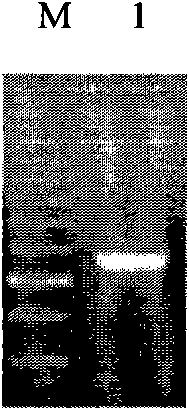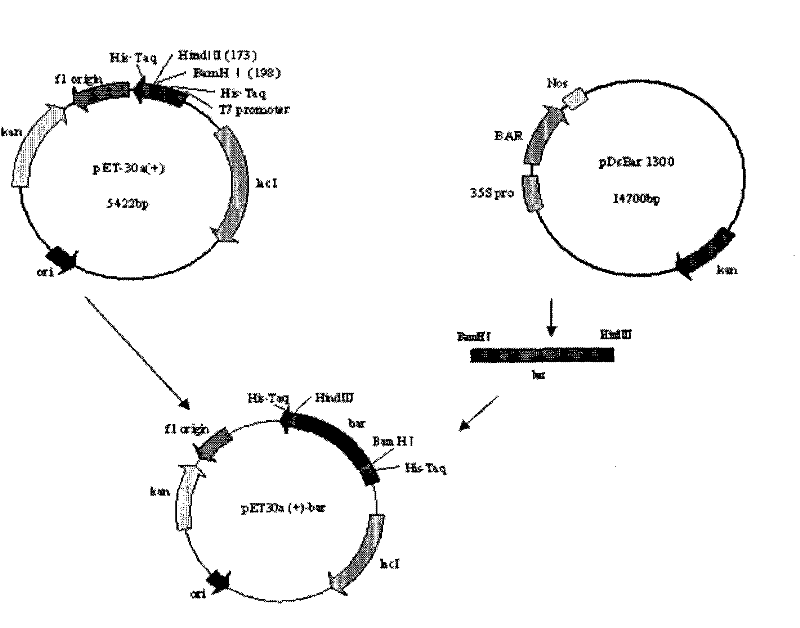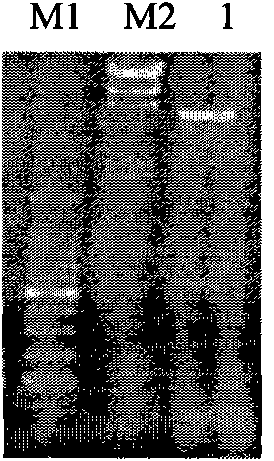Method for preparing recombinant phosphinthricin acetyltransferase (PAT)
A technology of phosphinothricin and transferase, which is applied in the biological field and can solve the problems of insufficient safety evaluation data
- Summary
- Abstract
- Description
- Claims
- Application Information
AI Technical Summary
Problems solved by technology
Method used
Image
Examples
Embodiment 1
[0042] Example 1: Design and synthesis of oligonucleotide primers
[0043] A pair of primers was designed based on the full-length nucleotide sequence of the bar gene,
[0044] Upstream primer bar1: CG GGATCC ATGAGCCCAGAACGACGC, the 5'end is designed with BamHI restriction endonuclease sequence (underlined part), and its nucleotide sequence is shown in SEQ No.1;
[0045] Downstream primer bar2: CCC AAGCTT ATCAAATCTCGGTGACGGGCAGG, 3'end is designed with HindIII restriction endonuclease sequence (underlined part), and its nucleotide sequence is shown in SEQ No.2.
Embodiment 2
[0046] Example 2: PCR amplification of the target fragment of bar gene
[0047] Using the plasmid pDsBar 1300 total DNA as a template, primers bar1 and bar2 were used to amplify the bar gene sequence. The PCR reaction system is: 10×Taq reaction buffer 2.5μL, 25mMMgCl in a total volume of 25μL 2 , 2.5mM dNTP, 10μM primer bar1, 10μM primer bar2, plasmid DNA 100ng, 0.5UTaq DNA polymerase, add ddH 2 O make up the volume to 25 μL. PCR reaction conditions are: 94°C pre-denaturation for 4 minutes; 94°C denaturation for 50s, 55°C annealing for 50s, 72°C extension for 50s, a total of 30 cycles; after the end of the cycle, 72°C extension for 10 minutes, the PCR amplification results are as follows figure 1 Shown. The results showed that the PCR amplified product of the bar gene had a specific band between 500 and 750 bp, which was consistent with the expected result.
Embodiment 3
[0048] Example 3: Construction and sequence determination of recombinant vector
[0049] The PCR product is separated by 1% agarose electrophoresis and the target fragment is recovered. The purified PCR product and the prokaryotic expression vector pET30a(+) are respectively subjected to BamHI and HindⅢ digestion treatment, and the target fragment with double sticky ends and expression are respectively recovered Carrier. Under the action of T4 ligase, ligate at 16°C for 3 hours to construct the prokaryotic expression plasmid pET30a(+)-bar, such as figure 2 Shown. Transform the recombinant plasmid into E.coli DH5α competent cells, pick the positive clones, extract the plasmid, and perform double enzyme digestion for identification, such as image 3 Shown. The recombinant plasmid DNA has specific target gene bands and pET30a(+) DNA vector bands between 500~750bp and 4361~6557bp, which are consistent with the expected results. Select positive clones and submit them to Shanghai Bi...
PUM
| Property | Measurement | Unit |
|---|---|---|
| molecular weight | aaaaa | aaaaa |
Abstract
Description
Claims
Application Information
 Login to View More
Login to View More - R&D
- Intellectual Property
- Life Sciences
- Materials
- Tech Scout
- Unparalleled Data Quality
- Higher Quality Content
- 60% Fewer Hallucinations
Browse by: Latest US Patents, China's latest patents, Technical Efficacy Thesaurus, Application Domain, Technology Topic, Popular Technical Reports.
© 2025 PatSnap. All rights reserved.Legal|Privacy policy|Modern Slavery Act Transparency Statement|Sitemap|About US| Contact US: help@patsnap.com



